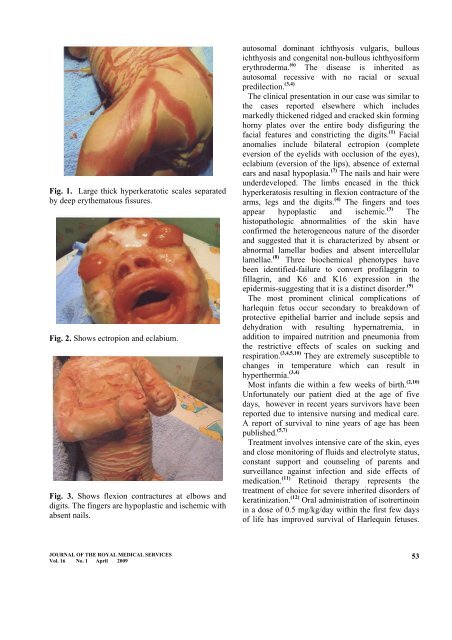A. Al-Issa, M. Khader, R. Muttair, B. Al-Rawashdeh
A. Al-Issa, M. Khader, R. Muttair, B. Al-Rawashdeh
A. Al-Issa, M. Khader, R. Muttair, B. Al-Rawashdeh
Create successful ePaper yourself
Turn your PDF publications into a flip-book with our unique Google optimized e-Paper software.
Fig. 1. Large thick hyperkeratotic scales separated<br />
by deep erythematous fissures.<br />
Fig. 2. Shows ectropion and eclabium.<br />
Fig. 3. Shows flexion contractures at elbows and<br />
digits. The fingers are hypoplastic and ischemic with<br />
absent nails.<br />
autosomal dominant ichthyosis vulgaris, bullous<br />
ichthyosis and congenital non-bullous ichthyosiform<br />
erythroderma. (6) The disease is inherited as<br />
autosomal recessive with no racial or sexual<br />
predilection. (3,4)<br />
The clinical presentation in our case was similar to<br />
the cases reported elsewhere which includes<br />
markedly thickened ridged and cracked skin forming<br />
horny plates over the entire body disfiguring the<br />
facial features and constricting the digits. (1) Facial<br />
anomalies include bilateral ectropion (complete<br />
eversion of the eyelids with occlusion of the eyes),<br />
eclabium (eversion of the lips), absence of external<br />
ears and nasal hypoplasia. (7) The nails and hair were<br />
underdeveloped. The limbs encased in the thick<br />
hyperkeratosis resulting in flexion contracture of the<br />
arms, legs and the digits. (4) The fingers and toes<br />
appear hypoplastic and ischemic. (3) The<br />
histopathologic abnormalities of the skin have<br />
confirmed the heterogeneous nature of the disorder<br />
and suggested that it is characterized by absent or<br />
abnormal lamellar bodies and absent intercellular<br />
lamellae. (8) Three biochemical phenotypes have<br />
been identified-failure to convert profilaggrin to<br />
fillagrin, and K6 and K16 expression in the<br />
epidermis-suggesting that it is a distinct disorder. (9)<br />
The most prominent clinical complications of<br />
harlequin fetus occur secondary to breakdown of<br />
protective epithelial barrier and include sepsis and<br />
dehydration with resulting hypernatremia, in<br />
addition to impaired nutrition and pneumonia from<br />
the restrictive effects of scales on sucking and<br />
respiration. (3,4,5,10) They are extremely susceptible to<br />
changes in temperature which can result in<br />
hyperthermia. (3,4)<br />
Most infants die within a few weeks of birth. (2,10)<br />
Unfortunately our patient died at the age of five<br />
days, however in recent years survivors have been<br />
reported due to intensive nursing and medical care.<br />
A report of survival to nine years of age has been<br />
published. (5,7)<br />
Treatment involves intensive care of the skin, eyes<br />
and close monitoring of fluids and electrolyte status,<br />
constant support and counseling of parents and<br />
surveillance against infection and side effects of<br />
medication. (11) Retinoid therapy represents the<br />
treatment of choice for severe inherited disorders of<br />
keratinization. (12) Oral administration of isotrertinoin<br />
in a dose of 0.5 mg/kg/day within the first few days<br />
of life has improved survival of Harlequin fetuses.<br />
JOURNAL OF THE ROYAL MEDICAL SERVICES<br />
Vol. 16 No. 1 April 2009<br />
53
















